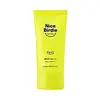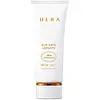What's inside
What's inside
 Key Ingredients
Key Ingredients

 Benefits
Benefits

 Concerns
Concerns

No concerns
 Ingredients Side-by-side
Ingredients Side-by-side

Water
Skin ConditioningZinc Oxide
Cosmetic ColorantPropylheptyl Caprylate
EmollientDibutyl Adipate
EmollientDipropylene Glycol
HumectantCyclohexasiloxane
EmollientMethyl Trimethicone
Skin ConditioningCaprylyl Methicone
Skin ConditioningPolyglyceryl-5 Polyricinoleate
EmulsifyingNiacinamide
SmoothingMethyl Methacrylate Crosspolymer
Polyglyceryl-3 Polydimethylsiloxyethyl Dimethicone
Skin ConditioningPolymethylsilsesquioxane
Disteardimonium Hectorite
StabilisingDiethylamino Hydroxybenzoyl Hexyl Benzoate
UV FilterBis-Ethylhexyloxyphenol Methoxyphenyl Triazine
Skin ConditioningEthylhexyl Triazone
UV AbsorberTitanium Dioxide
Cosmetic ColorantMagnesium Sulfate
Triethoxycaprylylsilane
1,2-Hexanediol
Skin ConditioningCalcium Aluminum Borosilicate
Polypropylsilsesquioxane
Glyceryl Caprylate
EmollientCaprylyl Glycol
EmollientJojoba Esters
EmollientEthylhexylglycerin
Skin ConditioningAdenosine
Skin ConditioningOctyldodecanol
EmollientHelianthus Annuus Seed Wax
Skin ConditioningSodium Hyaluronate
HumectantTocopherol
AntioxidantPolyglycerin-3
HumectantAcacia Decurrens Flower Wax
EmollientPropanediol
SolventHydrogenated Lecithin
EmulsifyingPolyglyceryl-10 Laurate
Skin ConditioningGlycolipids
Skin ConditioningCeramide NP
Skin ConditioningHydroxystearic Acid
CleansingOryza Sativa Bran Oil
EmollientGlycosphingolipids
EmollientGlycine Soja Sterols
Emollient7-Dehydrocholesterol
Emulsion Stabilising3-O-Ethyl Ascorbic Acid
Skin ConditioningEctoin
Skin ConditioningCaprylic/Capric Triglyceride
MaskingHippophae Rhamnoides Water
MaskingButylene Glycol
HumectantSimmondsia Chinensis Seed Oil
EmollientCaesalpinia Spinosa Fruit Extract
Skin ProtectingMethylpropanediol
SolventKappaphycus Alvarezii Extract
Skin ConditioningSqualane
EmollientLactobacillus Ferment
Skin ConditioningBuddleja Officinalis Flower Extract
UV FilterSolanum Lycopersicum Fruit Extract
AntioxidantLaminaria Ochroleuca Extract
Skin ConditioningPinus Pinaster Bark Extract
AntioxidantOenothera Biennis Flower Extract
AstringentUlmus Davidiana Root Extract
Skin ConditioningPinus Palustris Leaf Extract
TonicPueraria Lobata Root Extract
HumectantBackhousia Citriodora Leaf Extract
AstringentWater, Zinc Oxide, Propylheptyl Caprylate, Dibutyl Adipate, Dipropylene Glycol, Cyclohexasiloxane, Methyl Trimethicone, Caprylyl Methicone, Polyglyceryl-5 Polyricinoleate, Niacinamide, Methyl Methacrylate Crosspolymer, Polyglyceryl-3 Polydimethylsiloxyethyl Dimethicone, Polymethylsilsesquioxane, Disteardimonium Hectorite, Diethylamino Hydroxybenzoyl Hexyl Benzoate, Bis-Ethylhexyloxyphenol Methoxyphenyl Triazine, Ethylhexyl Triazone, Titanium Dioxide, Magnesium Sulfate, Triethoxycaprylylsilane, 1,2-Hexanediol, Calcium Aluminum Borosilicate, Polypropylsilsesquioxane, Glyceryl Caprylate, Caprylyl Glycol, Jojoba Esters, Ethylhexylglycerin, Adenosine, Octyldodecanol, Helianthus Annuus Seed Wax, Sodium Hyaluronate, Tocopherol, Polyglycerin-3, Acacia Decurrens Flower Wax, Propanediol, Hydrogenated Lecithin, Polyglyceryl-10 Laurate, Glycolipids, Ceramide NP, Hydroxystearic Acid, Oryza Sativa Bran Oil, Glycosphingolipids, Glycine Soja Sterols, 7-Dehydrocholesterol, 3-O-Ethyl Ascorbic Acid, Ectoin, Caprylic/Capric Triglyceride, Hippophae Rhamnoides Water, Butylene Glycol, Simmondsia Chinensis Seed Oil, Caesalpinia Spinosa Fruit Extract, Methylpropanediol, Kappaphycus Alvarezii Extract, Squalane, Lactobacillus Ferment, Buddleja Officinalis Flower Extract, Solanum Lycopersicum Fruit Extract, Laminaria Ochroleuca Extract, Pinus Pinaster Bark Extract, Oenothera Biennis Flower Extract, Ulmus Davidiana Root Extract, Pinus Palustris Leaf Extract, Pueraria Lobata Root Extract, Backhousia Citriodora Leaf Extract
Water
Skin ConditioningC12-15 Alkyl Benzoate
AntimicrobialEthylhexyl Methoxycinnamate
UV AbsorberButylene Glycol
HumectantPropanediol
SolventDiethylamino Hydroxybenzoyl Hexyl Benzoate
UV FilterBis-Ethylhexyloxyphenol Methoxyphenyl Triazine
Skin ConditioningTitanium Dioxide
Cosmetic ColorantDimethicone
EmollientTrisiloxane
Skin ConditioningCyclopentasiloxane
EmollientSilica
AbrasiveHamamelis Virginiana Leaf Water
AstringentTocopherol
AntioxidantPortulaca Oleracea Extract
Skin ConditioningLactobacillus/Water Hyacinth Ferment
Skin ProtectingPrunus Persica Leaf Extract
EmollientTocopheryl Acetate
AntioxidantMannitol
HumectantAscorbic Acid
AntioxidantCaffeic Acid
AntioxidantUbiquinone
AntioxidantLecithin
EmollientHelianthus Annuus Seed Oil
EmollientBeta-Carotene
Skin ConditioningHydrolyzed Millet
Skin ConditioningZinc Dna
Skin ConditioningDna
Skin ConditioningHydrogenated Phosphatidylcholine
EmulsifyingHydrolyzed Hibiscus Esculentus Extract
Skin ConditioningCholesterol
EmollientDextrin
AbsorbentDipalmitoyl Hydroxyproline
Skin ConditioningCholesteryl Hexyl Dicarbamate Pullulan
Copper Tripeptide-1
Skin ConditioningCalcium Pantetheine Sulfonate
Skin ConditioningAcrylates/Stearyl Methacrylate Copolymer
Emulsion StabilisingCyclohexasiloxane
EmollientPolyacrylate-13
Aluminum Stearate
Cosmetic ColorantPolyisobutene
Polyhydroxystearic Acid
EmulsifyingDimethicone/Vinyl Dimethicone Crosspolymer
Skin ConditioningAlumina
AbrasiveStearic Acid
CleansingCarbomer
Emulsion StabilisingEthylhexylglycerin
Skin ConditioningPolysorbate 20
EmulsifyingSorbitan Isostearate
EmulsifyingAmmonium Acryloyldimethyltaurate/Vp Copolymer
PEG-60 Hydrogenated Castor Oil
EmulsifyingXanthan Gum
EmulsifyingGlycerin
HumectantEthylhexyl Palmitate
EmollientMethoxy PEG-114/Polyepsilon Caprolactone
BufferingPentylene Glycol
Skin ConditioningAcrylates/Ammonium Methacrylate Copolymer
Caprylyl Glycol
EmollientHydroxyethyl Acrylate/Sodium Acryloyldimethyl Taurate Copolymer
Emulsion StabilisingTheobroma Cacao Extract
Skin ConditioningPolyacrylic Acid
Emulsion StabilisingAlcohol
AntimicrobialSodium Dehydroacetate
PreservativePotassium Sorbate
PreservativeCitric Acid
BufferingSodium Benzoate
Masking1,2-Hexanediol
Skin ConditioningDisodium EDTA
CI 77891
Cosmetic ColorantPhenoxyethanol
PreservativeParfum
MaskingWater, C12-15 Alkyl Benzoate, Ethylhexyl Methoxycinnamate, Butylene Glycol, Propanediol, Diethylamino Hydroxybenzoyl Hexyl Benzoate, Bis-Ethylhexyloxyphenol Methoxyphenyl Triazine, Titanium Dioxide, Dimethicone, Trisiloxane, Cyclopentasiloxane, Silica, Hamamelis Virginiana Leaf Water, Tocopherol, Portulaca Oleracea Extract, Lactobacillus/Water Hyacinth Ferment, Prunus Persica Leaf Extract, Tocopheryl Acetate, Mannitol, Ascorbic Acid, Caffeic Acid, Ubiquinone, Lecithin, Helianthus Annuus Seed Oil, Beta-Carotene, Hydrolyzed Millet, Zinc Dna, Dna, Hydrogenated Phosphatidylcholine, Hydrolyzed Hibiscus Esculentus Extract, Cholesterol, Dextrin, Dipalmitoyl Hydroxyproline, Cholesteryl Hexyl Dicarbamate Pullulan, Copper Tripeptide-1, Calcium Pantetheine Sulfonate, Acrylates/Stearyl Methacrylate Copolymer, Cyclohexasiloxane, Polyacrylate-13, Aluminum Stearate, Polyisobutene, Polyhydroxystearic Acid, Dimethicone/Vinyl Dimethicone Crosspolymer, Alumina, Stearic Acid, Carbomer, Ethylhexylglycerin, Polysorbate 20, Sorbitan Isostearate, Ammonium Acryloyldimethyltaurate/Vp Copolymer, PEG-60 Hydrogenated Castor Oil, Xanthan Gum, Glycerin, Ethylhexyl Palmitate, Methoxy PEG-114/Polyepsilon Caprolactone, Pentylene Glycol, Acrylates/Ammonium Methacrylate Copolymer, Caprylyl Glycol, Hydroxyethyl Acrylate/Sodium Acryloyldimethyl Taurate Copolymer, Theobroma Cacao Extract, Polyacrylic Acid, Alcohol, Sodium Dehydroacetate, Potassium Sorbate, Citric Acid, Sodium Benzoate, 1,2-Hexanediol, Disodium EDTA, CI 77891, Phenoxyethanol, Parfum
Ingredients Explained
These ingredients are found in both products.
Ingredients higher up in an ingredient list are typically present in a larger amount.
1,2-Hexanediol is a synthetic liquid and another multi-functional powerhouse.
It is a:
- Humectant, drawing moisture into the skin
- Emollient, helping to soften skin
- Solvent, dispersing and stabilizing formulas
- Preservative booster, enhancing the antimicrobial activity of other preservatives
You might know this ingredient as Tinosorb S or Bemotrizinol. It is a UV filter that covers both UVA and UVB rays.
This ingredient has two peak UV absorption peaks ( 310 and 340 nm) and is able to absorb both UV-A and UV-B rays. This ingredient works by preventing UV rays from reaching and damaging your skin.
On top of that - it is highly photostable and helps prevent the photodegration of other sunscreen ingredients such as avobenzone.
Tinosorb S is allowed in the EU, Australia, and Asia. It is close to being approved by the FDA and we'll hopefully get this ingredient in the U.S. by late 2025.
Fun fact: Tinosorb S is the most effective UV absorber at maximum concentration (measured by SPF) permitted in the EU.
This ingredient is oil-soluble, so your oil-cleansers will take this right off at night.
Learn more about Bis-Ethylhexyloxyphenol Methoxyphenyl TriazineButylene Glycol (or BG) is used within cosmetic products for a few different reasons:
Overall, Butylene Glycol is a safe and well-rounded ingredient that works well with other ingredients.
Though this ingredient works well with most skin types, some people with sensitive skin may experience a reaction such as allergic rashes, closed comedones, or itchiness.
Learn more about Butylene GlycolCaprylyl Glycol is a humectant and emollient, meaning it attracts and preserves moisture.
It is a common ingredient in many products, especially those designed to hydrate skin. The primary benefits are retaining moisture, skin softening, and promoting a healthy skin barrier.
Though Caprylyl Glycol is an alcohol derived from fatty acids, it is not the kind that can dry out skin.
This ingredient is also used as a preservative to extend the life of products. It has slight antimicrobial properties.
Learn more about Caprylyl GlycolCyclohexasiloxane is a type of silicone more commonly known as D6. It is an emollient and solvent.
Cyclohexasiloxane is used to evenly distribute ingredients throughout the product. When applied to the skin, Cyclohexasiloxane evaporates and leaves behind a silky feel.
As an emollient, it can help the skin feel soft and hydrated. It is also used to reduce frizz in hair products.
Learn more about CyclohexasiloxaneDiethylamino Hydroxybenzoyl Hexyl Benzoate (DHHB) is a chemical UV-A absorber. It is formulated for high UVA protection (320-400 nm).
DHHB is well-liked for:
DHHB has been approved by the EU, Japan, Taiwan, and South America for use up to 10%. Unfortunately, it has not been approved for use in the US or Canada due to slow regulatory processes.
This ingredient is soluble in oils, fats, and lipids.
Learn more about Diethylamino Hydroxybenzoyl Hexyl BenzoateEthylhexylglycerin (we can't pronounce this either) is commonly used as a preservative and skin softener. It is derived from glyceryl.
You might see Ethylhexylglycerin often paired with other preservatives such as phenoxyethanol. Ethylhexylglycerin has been found to increase the effectiveness of these other preservatives.
Propanediol is an all-star ingredient. It softens, hydrates, and smooths the skin.
It’s often used to:
Propanediol is not likely to cause sensitivity and considered safe to use. It is derived from corn or petroleum with a clear color and no scent.
Learn more about PropanediolTitanium dioxide is a mineral UV filter widely used in sunscreens and cosmetics.
It is one of only two UV filters officially classified as “mineral” by regulatory agencies, the other being zinc oxide.
Titanium dioxide provides broad-spectrum protection mostly in the UVB and UVAII range, with some protection in the UVAI range.
While its UVA protection isn’t as strong as zinc oxide’s, the difference is minor.
A common myth is that mineral UV filters reflect UV light. However, modern research shows titanium dioxide absorbs UV radiation like chemical filters (~95% absorption & 5% reflection).
Thanks to its non-irritating nature, titanium dioxide is suitable for sensitive, acne-prone, or redness-prone skin. It is unlikely to cause "eye sting" like other sunscreen ingredients.
A major drawback of this ingredient is its white cast and thick texture. This is why mineral sunscreens often leave a white cast and are less cosmetically elegant than chemical/hybrid sunscreens.
To improve white cast and spreadability, micronized or nano-sized titanium dioxide is often used.
There are ongoing concerns surrounding nano-titanium oxide's impact on marine ecosystems.
There is no conclusive evidence that any form of titanium oxide (or any other sunscreen ingredients) will cause harm to marine ecosystems or coral reefs. The science is still developing but many consumers are keeping a close eye on this issue.
Please note, many destinations have reef-safety sunscreen rules. For instance, the U.S. Virgin Islands advises all visitors to use non-nano mineral sunscreens.
Nano mineral sunscreens once raised safety concerns about absorption into skin.
Extensive research has shown that they do not penetrate healthy or damaged skin; they remain safely on the surface and the top layer of dead skin (stratum corneum).
You'll likely find titanium dioxide bundled with alumina, silica, or dimethicone. These ingredients help make titanium dioxide highly photostable; this prevents it from interacting with other formula components under UV light.
Learn more about Titanium DioxideTocopherol (also known as Vitamin E) is a common antioxidant used to help protect the skin from free-radicals and strengthen the skin barrier. It's also fat soluble - this means our skin is great at absorbing it.
Vitamin E also helps keep your natural skin lipids healthy. Your lipid skin barrier naturally consists of lipids, ceramides, and fatty acids. Vitamin E offers extra protection for your skin’s lipid barrier, keeping your skin healthy and nourished.
Another benefit is a bit of UV protection. Vitamin E helps reduce the damage caused by UVB rays. (It should not replace your sunscreen). Combining it with Vitamin C can decrease sunburned cells and hyperpigmentation after UV exposure.
You might have noticed Vitamin E + C often paired together. This is because it is great at stabilizing Vitamin C. Using the two together helps increase the effectiveness of both ingredients.
There are often claims that Vitamin E can reduce/prevent scarring, but these claims haven't been confirmed by scientific research.
Learn more about TocopherolWater. It's the most common cosmetic ingredient of all. You'll usually see it at the top of ingredient lists, meaning that it makes up the largest part of the product.
So why is it so popular? Water most often acts as a solvent - this means that it helps dissolve other ingredients into the formulation.
You'll also recognize water as that liquid we all need to stay alive. If you see this, drink a glass of water. Stay hydrated!
Learn more about Water